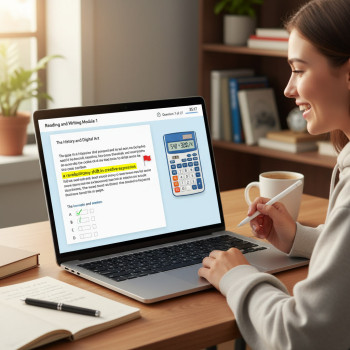Why This Question Matters: Data Is Everywhere Which Path Teaches It Best?
Walk into any classroom, science lab, or news feed and you ll see numbers and charts telling stories. From COVID case curves to climate graphs, from economics dashboards to class lab results the college and career world expects students to read, question, and use data. That s why parents and students often ask: should I invest my time in AP courses (like AP Statistics or AP Biology) or focus on mastering the Digital SAT s math and data items to get better at data and graph literacy? Spoiler: both help, but in different ways.

Who this article is for
If you’re a high school student, a parent mapping academic choices, or a counselor helping craft a course plan, this article will walk you through practical differences and overlaps in how AP courses and the Digital SAT build skills in interpreting data, spotting trends, and communicating conclusions. We’ll look at classroom learning, exam formats, real-world transferability, and how targeted tutoring such as Sparkl s personalized 1-on-1 guidance with tailored study plans and AI-driven insights can accelerate progress where it’s needed most.
At a Glance: What AP Courses and the Digital SAT Aim to Teach
Both AP courses and the Digital SAT include data and graph literacy, but their goals, depth, and methods differ. Here s a quick snapshot before we unpack each.
| Dimension | AP Courses (e.g., AP Statistics, AP Biology) | Digital SAT |
|---|---|---|
| Primary aim | Teach discipline-specific, college-level concepts and methods; build sustained project and analysis skills | Assess core readiness skills and reasoning under timed conditions; measure ability to interpret and use data |
| Depth | High multi-week units, labs, and projects | Moderate focused item sets and applied questions |
| Format | Classroom instruction, labs, AP Classroom resources, end-of-year exam (May) | Digital adaptive test, shorter sections, problem sets with charts and tables |
| Skill transfer | Strong for college courses and research; emphasises methodology and deeper statistical thinking | Strong for quick decision-making, interpreting applied graphs, and standardized comparisons |
AP Courses: Building Data Literacy from the Ground Up
Advanced Placement classes like AP Statistics along with AP subjects that use data heavily (Environmental Science, Biology, Economics, Psychology, Computer Science) treat data literacy as a discipline. Here s what that typically looks like in practice.
Curriculum and classroom practice
- Multi-week units: Lessons sequence from question framing to data collection, analysis, and interpretation.
- Hands-on labs and projects: Students often design studies, gather or simulate data, and write up conclusions the kind of work that mirrors college coursework.
- Formal vocabulary and methods: Concepts like sampling methods, bias, confidence intervals, hypothesis testing, correlation versus causation, and regression appear and are practiced in depth.
- Frequent formative feedback: AP Classroom resources and teacher-led assessments give iterative feedback that refines reasoning and technical skills.
In short: AP teaches not just how to read a graph, but how to think as a data investigator.
Exam expectations
AP exams test mastery with longer problem sets and free-response questions that demand explanation, justification, and correct interpretation of results. For AP Statistics, this can mean interpreting residuals in regression or describing the limitations of an experimental design. Those free-response parts force students to explain what the numbers mean a vital part of true data literacy.
Real-world payoff
Students who complete AP courses tend to be better prepared for college-level lab work, research projects, and courses that require sustained data analysis. AP also signals to colleges readiness for rigorous coursework and can sometimes earn college credit.
The Digital SAT: Focused, Practical, and Efficiency-Driven
The Digital SAT s recent transformation emphasizes shorter test length, digital delivery, and adaptive design. It still includes graph and data interpretation items often integrated into word problems or evidence-based reading passages. The SAT s approach builds a different, but complementary, kind of data literacy.
What data questions look like on the Digital SAT
- Concise, applied items: Expect a chart or scatterplot plus one or two targeted questions about slope, trend, or interpretation.
- Multiple representations: Tables, bar graphs, line graphs, and simple regressions may be shown; items test rapid comprehension and correct numerical reasoning.
- Skills insights: Score reports often include domain breakdowns (e.g., math domains) that help students see strengths and weaknesses in data-related areas.
The SAT rewards quick, accurate reading and efficient problem solving under time pressure. It s less about designing a study and more about interpreting given data correctly.
Why the SAT s version of data literacy matters
In many real-world situations standardized reporting, business dashboards, policy briefs you need to interpret a chart quickly and make a judgment. The Digital SAT hones that exact muscle: reading a graph, extracting the right value, understanding context clues, and avoiding trap answers. For college admissions, the SAT provides a standardized measure of those practical skills.
Comparing Outcomes: Depth vs. Breadth
When choosing between AP and SAT preparation for data and graph literacy, think about whether you want deep methodological understanding or efficient interpretation skill ideally, both.
How AP wins
- Depth: You learn experimental design, inference, and the logic behind statistical conclusions.
- Communication: AP often requires written explanations, which builds the ability to justify claims using data.
- College alignment: AP mirrors introductory college courses, making the transition smoother for data-heavy majors.
How the Digital SAT wins
- Speed and efficiency: You learn to read graphs fast and pick the correct interpretation under time limits.
- Consistency: Standardized tasks make it easy to identify and strengthen specific weaknesses.
- Admissions value: A strong SAT score is a recognizable signal to colleges about quantitative readiness.
Complementary, Not Competitive: How to Combine Both
The best strategy for most students is not choosing one over the other but layering them.
- Use AP for foundation: Take AP Statistics or a data-heavy AP science to ground your reasoning and give you practice designing and defending analyses.
- Use SAT prep for polish: Target SAT practice to increase speed, accuracy, and test-taking technique on graph interpretation items.
- Leverage feedback loops: Use SAT score reports and classroom feedback to identify weak points (e.g., interpreting slope vs. average rate) and address them in class or tutoring.
Sample plan (junior year)
- Fall: Build base complete AP Statistics unit on data collection and descriptive statistics; begin diagnostic SAT to set target scores.
- Winter: Reinforce practice SAT data items for efficiency; use AP free-response practice to strengthen written explanations.
- Spring: Test and reflect take the Digital SAT practice test; review AP exam-style questions to close gaps.
How Targeted Tutoring Accelerates Data Literacy
Personalized tutoring accelerates improvement because it adapts to specific student needs. If you need speed, a tutor can time drills and teach shortcuts. If you need conceptual depth, a tutor can scaffold statistical thinking and provide step-by-step feedback on written explanations.
Sparkl s personalized tutoring model is a good example of how this blend works in practice: one-on-one guidance helps students strengthen weak spots, tailored study plans sequence content meaningfully, expert tutors show how classroom concepts map to test questions, and AI-driven insights help track progress so every session is efficient and focused.
What to expect from effective tutoring for data skills
- Diagnostic assessment to find precise gaps (e.g., reading residual plots, interpreting confidence intervals, or comparing rates of change).
- Targeted drills for fluency on SAT-style items and deeper problem sets for AP-style reasoning.
- Practice with real charts and messy, real-world data to build transferable skills.
- Timed practice plus strategies for pacing, estimation, and educated guessing on the SAT.
Concrete Examples: Putting Theory into Practice
Let s look at two short, practical examples that show where AP and SAT differ in approach.
Example 1 Interpreting a Scatterplot
AP approach: Describe correlation, consider the residuals, discuss possible confounders, and, if given, perform or interpret a regression analysis with slope and intercept meaningfully connected to context.
SAT approach: Identify the general trend (positive/negative), pick the closest trendline or numeric estimate requested, and avoid careless arithmetic errors under time pressure.
Example 2 Evaluating a Bar Chart in a Passage
AP approach: Ask whether the chart s sampling method could bias the result, discuss margin of error, and write a short explanation of what the data supports.
SAT approach: Read the passage and chart to answer targeted questions (e.g., which year had the largest percentage increase), and use only the graph s provided facts to answer the item.
Practical Advice: Course Selection and Test Prep Resources
Choosing the right mix depends on your goals, timeline, and strengths.
- If your goal is strong college readiness for data-driven majors (Economics, Biology, Engineering, Psychology), prioritize AP Statistics plus targeted SAT prep.
- If you re short on time but need to maximize college admissions outcomes, prioritize efficient SAT prep to raise your score while taking at least one AP or honors-level quantitative course.
- If you love hands-on learning and plan to do research or advanced coursework in college, AP courses give the best long-term foundation.
Study tips that work for both AP and SAT
- Work from real data: practice with datasets and charts from class, news stories, or AP Classroom resources.
- Explain your reasoning out loud: teaching a concept helps solidify it.
- Time yourself on SAT-style items but also take deep, untimed practice for AP free responses.
- Use score reports and classroom feedback to personalize study topics focus on the 20% of skills that unlock 80% of answers.

Quick Reference Table: Skills, Examples, and Where to Practice Them
| Skill | AP Environment | Digital SAT Environment | Where to Practice |
|---|---|---|---|
| Designing studies | Labs and projects, semester-long tasks | Not assessed directly | AP class, science labs, independent projects |
| Interpreting regression | Detailed interpretation and free-response analysis | Quick slope or trend questions | AP Statistics practice, tutor sessions |
| Reading charts and tables | In context of experiments and reports | Timed multiple-choice items | AP homework, SAT practice sets |
| Writing about data | Free-response requires justification | Usually not required | AP exam writing, lab reports, tutor feedback |
Final Thoughts: Which Builds It Better?
There isn t a single correct answer. If by “better” you mean depth, sustained practice, and college-like experience AP courses win. If by “better” you mean quick, portable test-ready skills useful for admissions and rapid decision-making the Digital SAT is a highly efficient trainer. For students serious about data literacy, the smart path is to combine both: use AP for a foundation and the Digital SAT for speed and polish.
And if you want to fast-track progress, a thoughtful blend of classroom learning and personalized tutoring pays off. Sparkl s approach 1-on-1 guidance, tailored study plans, expert tutors, and AI-driven insights can help students connect AP-level conceptual depth to SAT-style efficiency so they don t have to choose between depth and speed.
Next steps for families and students
- Talk with your counselor about AP course availability and prerequisites.
- Take a digital SAT diagnostic to identify target areas for quick gains.
- Consider a short tutoring engagement to bridge specific gaps between AP concepts and SAT item styles.
- Practice with real charts from class, news, and practice tests and always write an explanation for at least some problems; explaining builds durable understanding.
Parting Metaphor: Learning to Read Maps and Then Navigate
Think of AP courses as teaching you how to read and draw complex maps: contour lines, scales, and the reasons we create maps in the first place. The Digital SAT is like a timed navigation challenge you re given a map and must use it quickly to make the right choice. Master both, and you ll not only know what the map shows but also be the fastest, most confident navigator when decisions matter.
Good luck and remember: data literacy is a lifelong skill. Which route you prioritize now should fit your goals, curiosity, and the timeline you have for college planning. If you d like, we can map out a personalized study plan that combines AP coursework goals with Digital SAT practice and highlight how short, focused tutoring bursts can accelerate the most critical skills.

















No Comments
Leave a comment Cancel